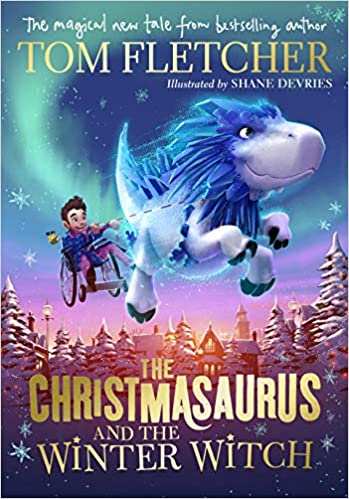
Price: £12.99
Publisher: Puffin
Genre: Fiction
Age Range: 8-10 Junior/Middle, 10-14 Middle/Secondary
Length: 432
- Illustrated by: Shane Devries
The Christmasaurus and the Winter Witch
Illustrator: Shane DevriesThis book is the sequel to Fletcher’s first novel, The Christmasaurus. William Trundle is aged ten, a wheelchair user. His father is devoted to Christmas. The first volume of this story featured a girl named Brenda Payne, who was something of a bully. Then she and William became friends, as also did William’s father and Brenda’s mother. William’s mother has died but Brenda’s father is still alive.
In this volume Brenda and her mother together with William and his father visit the North Pole to see Santa Claus, whom they have already befriended. At the Pole they also meet the dinosaur who had become William’s friend – the Christmasaurus. When they return from Brenda must go and stay with her father Barry Payne. Mr Payne is a toy manufacturer who loathes Christmas. Barry has a plan to disrupt Christmas and unintentionally Brenda gets to help him. The plan will disrupt time itself so that Christmas disappears. All the children with the help of the Christmasaurus have to try to restore time and recover Christmas. The crucial question is whether they will succeed?
Any reader who loves Christmas, and in particular those who are young, will relish this story. It explores all the secrets of the North Pole, doing so with a powerful attention to detail. Some twists and turns of the narrative through time travel are fairly complex and young readers may need to concentrate hard to follow these turns. The attempt to unify these elements into a coherent narrative is not completed until the very end of the book and in the meantime the pace occasionally slackens.
Having a protagonist in a wheelchair is a worthy narrative device and deserves plaudits. Sometimes the effects of being in a wheelchair while experiencing time travel are made explicit – effects such as exhaustion or disorientation. On other occasions Fletcher writes as if being in a wheelchair is just like not being in a wheelchair – which is far from the truth.
Devries’s illustrations serve excellently to realise the landscape of the polar waste and to punctuate episodes of a narrative that might otherwise be too long for this age group.



